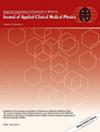Impact of extended source-to-surface distances and respiratory motion on the precision of electron beam therapy
Abstract
Purpose
In electron beam therapy targeting superficial thoracic and abdominal lesions, the source-to-surface distance (SSD) varies due to patient respiration. This study aimed to investigate the percentage depth dose (PDD) and off-center ratio (OCR) of 6, 9, and 12 MeV electron beams at extended SSDs; and to assess the variations in dose caused by respiratory motion.
Methods
PDDs and OCRs for 6, 9, and 12 MeV electron beams were measured using a Blue Phantom 2 with 5 cm circular aperture and 10 × 10 cm2 fields at SSDs ranging from 98 to 105 cm. The dose differences at the maximum depth (dmax) were calculated relative to an SSD of 100 cm. We simulated patient respiratory motion of 0–4 cm during irradiation with 5 cm circular aperture and 10 × 10 cm2 fields by placing a water-equivalent phantom with a parallel-plate ionization chamber on a QUASAR Platform. The gantry angle was set to 270°, and the SSD was set to 100 cm. The dose differences at dmax were calculated relative to a motion amplitude of 0 cm.
Results
Extending the SSD by 3 cm reduced the dose by > 5% for all energies. For a 6 MeV electron beam with a 5 cm circular aperture, extending the SSD to 105 cm resulted in a dose reduction of 13.42% and expansions of the field size by 2.0 mm and the penumbra by 4.2 mm. A respiratory motion amplitude of 3 cm resulted in dose variations of > 3% for all energies and field sizes. The largest dose difference of 5.36% was observed for a 6 MeV electron beam with a 5 cm circular aperture.
Conclusions
The results demonstrate that extending the SSD by 3 cm reduced the dose by >5% for all energies, providing a useful quantitative benchmark for quality assurance in superficial electron therapy. Respiratory motion management may be warranted for electron beam therapy when respiratory-induced SSD variations exceed 3 cm.


 求助内容:
求助内容: 应助结果提醒方式:
应助结果提醒方式:


